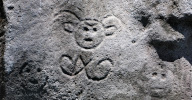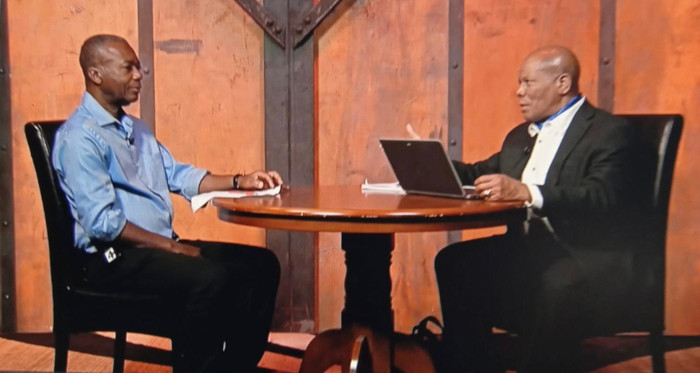| Kaz | Enfo | Ayiti | Litérati | KAPES | Kont | Fowòm | Lyannaj | Pwèm | Plan |
| Accueil | Actualité | Haïti | Bibliographie | CAPES | Contes | Forum | Liens | Poèmes | Sommaire |
Haitian Creole, from colonial times to 2022
Photo: Orèsjozèf (Tele Kreyòl) interviewing E. W. Védrine English • Haitian Creole (Kreyol) • Video• Updated January 8, 2023 Author’s biography • Praises • Send your comments “Ask not what Kreyol can do for you, but what you can do for Kreyol” (E. W. Védrine). |
30 (Thirty) Years of Research & Publications on Haiti,
The Haitian Diaspora and on Haitian Creole
• Bibliographies on Haitian Creole (from colonial times to 2022) • Bilingual Education • Conferences • Foreign Language Teaching & Teaching Materials for schools in Haiti • Formation Training for Haitian Teachers • Formation Training for Haitian Youth in Haiti • Haitian Bilingual Programs • Haitian Communities in Diaspora • Haitian Creole Bibliography (from colonial times to 2022 [Authors' Index; Index of Titles]) • Haitian Diaspora (Research & Writing) • Haitians in the US • Learners of Haitian Creole (Kreyol) • Literacy in Haitian Creole (Kreyol) • Teaching Materials Development (Haitian Creole - English) • Translation & Editing (Haitian Creole - English : English - Haitian Creole) •
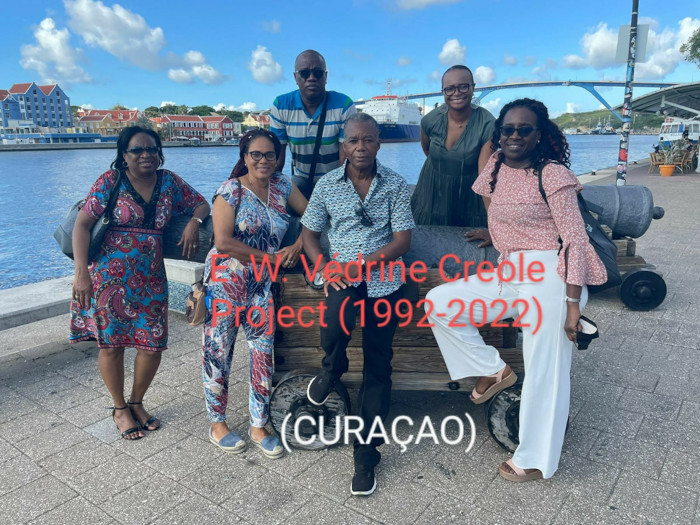
Photo: Enoch Pinedo. January 15, 2022. Punda, Curacao (Pais Kòrso)
(SOME) COUNTRIES & CREOLE SPEAKING REGIONS: • Aruba • Haiti • Bonaire (Boneiru) • Curaçao (Pais Kòrso) • French Guiana • Guadeloupe • Jamaica • Cape Verde Islands • Cuba • Louisiana (USA) • Matinique • Mauritius • Reunion • Dominican Republic • Rodrigues • Seychelles Islands • Saint Bart • Saint Lucia • Trinidad & Tobago
I am greeting all Kreyòl Tele viewers. My name is Orèsjozèf. We are inviting you to watch Tele Kreyòl. We have already announced it since September that the month of October is Haitian Creole Month. There are many activities taking place in various regions of the United States, as well as in the diaspora (France, Canada, the Caribbean...) and everywhere there are many Haitians – in the Kreyol language. You’ve seen together with us where we invited many pioneers documenting what have been publishing such as books and make program in Kreyol in order to have a continuity with this program. Tonight, our special guest is Emmanuel W. Védrine. We welcome you at Tele Kreyòl.
Thank you, compatriot Orèsjozèf for the invitation! It has been a long time since I stopped by Tele Kreyòl, over 20 years. I'm happy to be back home.
I am glad Védrine. You (viewers) can invite a friend, family, invite them to watch Tele Kreyòl. Tuesday at 7:00 pm live. You can also watch Tele Kreyòl on Patriot Tele every Saturday at 8:00 am. You can watch Tele Kreyòl directly on Click on Community TV watch now. And if you don't have time to do that today, you can watch it another day on Community TV, and go to “VOD” (Video On Demand). You will look at the page above, click on Tele Kreyòl (the most recent show)... Once again, thank you for watching Tele Kreyòl. Remember that I am Haitian, you who are also watching it, we speak Kreyol. So, we encourage all Haitians so that we remain connected to our mother tongue, the native language. But, we are also fighting because the native language is not yet taught at all levels (primary, secondary, university) in Haiti. Once again, we introduce you to Emmanuel W. Védrine who will tell us who he is.
Emmanuel W. Védrine was born in (the commune of) Lazil (L’Asile), Haiti (15 January 1959).
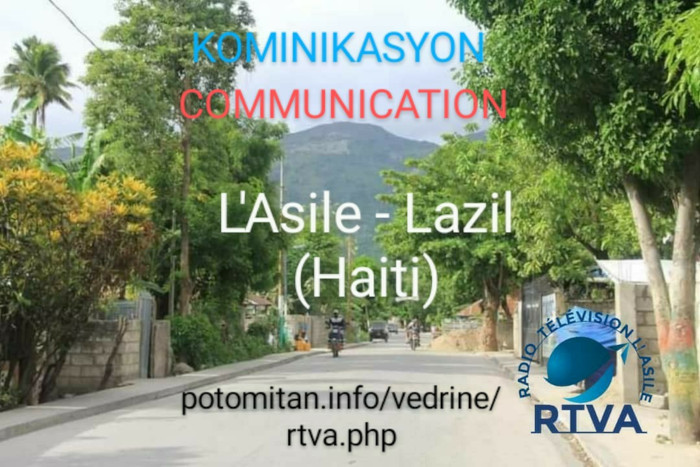
Photo: L’Asile Touristique Forum
He came to Port-au-Prince to continue his (primary) education in September 1969. So, he lived in Port-au-Prince. He would go to Lazil and Croix-des-Bouquets (Kwadèboukè) during the summer vacation. He made his first contact with another Haitian Creole variation* in Croix-des-Bouquets, precisely in (the town of) Koten (1970), where he began observing how people from other parts of Haiti speak Kreyol but we did not have problems understanding each other. We did not have any communication problem. We left Port-au-Prince in February 1976 (aboard Pan Am). First, it landed in Miami. From there, the American Immigration printed out my residence card (called alien card that time). Then we waited for Eastern Airlines that would leave Miami for Boston (at 9:00 p.m.). We landed in Boston (at Logan International Airport) around midnight. We could say we landed in Boston on February 20, 1976. But since February 19, 1976, I have left Haiti.
Védrine, we know your contributions to a wide range of works in / on Haitian Creole. Tell us when you really started out to get involved in the Creole issue, the native language? How did you start with the Creole (language) issue because your reference to the time you mention here, there was variation in writing Kreyol (or in its writing)*. How did you start?
To tell you the truth, since my childhood I grew up in a very poetic environment with three rivers (Depen, Sèpan, Mawo) near our home. When we opened our windows, we would look at the most beautiful mountain that had many guineafowls, and many types of birds. So, not to become a poet would be really rare.
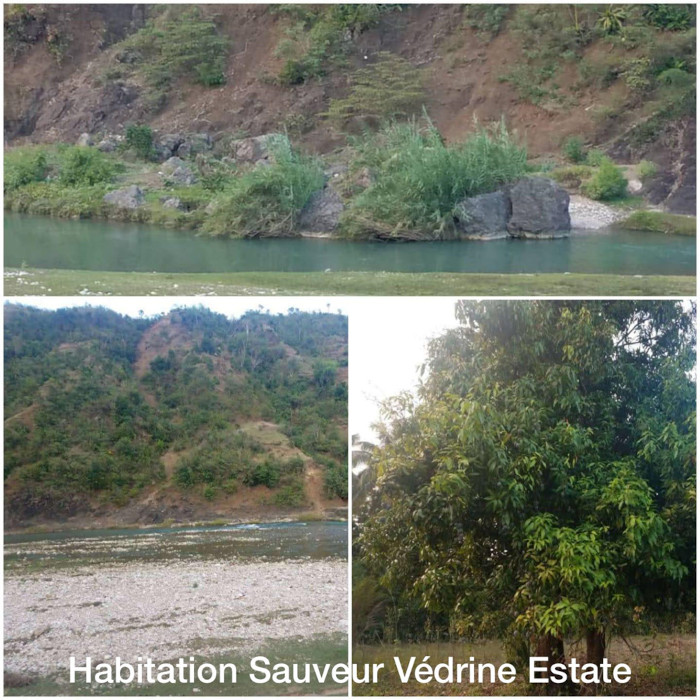
Photo: E. W. Védrine Creole Project Archives. Tournade (Tounad) & Mathias (Matyas). L’Asile (Lazil). Haiti
O.k.
You have all the ingredients of nature (the animals that are my friends, birds...). So, I had a desire to write since I was young, but you don't have training, you don't have a mentor (coach), you don't know people who are already writers as models where you would say "hey, I want to write." Seeing all this happening, you would like to see them on paper. So, that idea has always been in my mind since my childhood, I want to write. In college or university, I studied Letters, Linguistics. In Letters, we did Comparative Literature (French and Spanish). We did General Linguistics. We did Social Sciences (with focus on Philosophy and Psychology) in Undergraduate Studies (or the first university cycle). In Graduate Studies (second cycle), we did Education (Pedagogy). I took many courses in Pedagogy; for example, to become a Certified Teacher (G7 – 12) [from 7th to 12th grade] High School Teacher (Secondary School) in the USA for Haitian Bilingual Program, French and Spanish). In Graduate School, we also did Graduate Studies from Hispanic Studies, French Linguistics (at Indiana University), Dept. of French & Italian (Frit) and we had the chance to get a scholarship to start our Doctorate (Ph.D) Program in Theoretical Linguistics at Harvard University (1993). But my real experience was in the Haitian Bilingual Program that I would do it when I started teaching in 1986 (Boston Public Schools).
In 1986, you began teaching in the Haitian Bilingual Program, what language did you use as instructional tool or to make students understand you better?
Well, the official language of the bilingual program is the language of the children (Kreyol). That is, categorically speaking it’s Haitian Creole, the official language of the Haitian Bilingual Program. So, if you are hired to teach in Haitian Bilingual, the language that you are going to use is Haitian Creole. There was an older (Haitian) generation of teachers for example that was in Africa; they always believed that it would be better to keep French (as the language of instruction), but Haitian Creole is the dominant language of all children. Though they were trying to keep French but Haitian Creole invaded them. They could not resist in a way. We must also say that during the era of the Duvalier’s dictatorship (father and son) collapsed in Haiti (February 7, 1986) there was wave of children coming to the United States. There was a need to have the bilingual program to explain everything to them (in their native language), regardless the subject the teacher was teaching for example (whether it was Mathematics, Social Science, other courses, Biology…) so you must teach it in the child's language in order to grasp it was quickly.
That means the transition tool is Haitian Creole - English?
That is, even if you were teaching a Social Science class, you have to explain everything in Kreyol while the textbook is in English. As teacher, it’s like you were doing three times the work of an American teacher's job, for example. Not only you are going the explain to them (in their native language) the textbook (written) in English, you summarize it in Kreyol. Now, I also gave them the choice to write in 3 languages. So students never had problems in my class. According to their level, some of them have left at a moderate level; they could write in French; there were also those who could not. So, I made it in an easy way for everyone. What I need is the answer. I don't care if they wrote in French, in Kreyol or English. I want you to show me that you understand the subject I presenting or teaching (be it American History, General History…). So when I ask questions now, you write in your chosen language.
Now, what about the (teaching) teaching material? You say that you were using materials in English in order be able to make the transition; you give explanations in Kreyol, but your assignments were in Kreyol or in the 3 three languages you mention here?
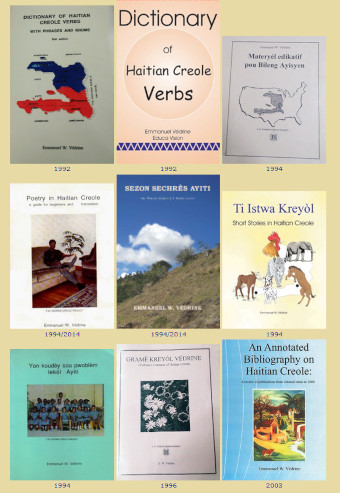
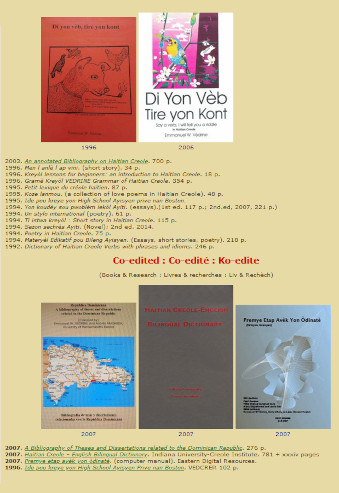
Some teaching materials for Haitian Bilingual Programs by E. W. Védrine
Well, when I gave assignment I had to help the students learning English as fast as possible. That is one of the obligation for example because the bilingual program is a transitional one.
That has a three-year duration.
Well, they don't want the student to stay the entire three years in the transitional program. So, as you know the policy, someone who knows the students’ problems in Haiti, you are doing everything to help them mastering the English language quickly to give them all tools in Kreyol, explain to them everything so that they grasp everything. Now, when you are writing, you give them choices to write in one of the three languages to write.
While talking about this wave, that arrive in the United States in 1986, were there among these children those you could notice who could not read or write in Kreyol?
Yes. We faced a big problem like that. You could find students ages 16, 17, 18 who were reading at a 4th grade level. We identified some who were at that level. So, they came from Haiti with their problems. They did not have the chance to attend school for many years. They had economic problems (back home); they didn’t have access to schools at all for instance. It’s all these problems bilingual teachers were going to face (whether at the middle school, or at the High School*or secondary, well they would face these types of students for example.
That lasts three years.
Well, they don't want the student to stay the entire three years in the transitional program. So, as you know the policy, someone who knows the students’ problems in Haiti, you are doing everything to help them mastering the English language quickly to give them all tools in Kreyol, explain to them everything so that they grasp everything. Now, when you are writing, you give them choices to write in one of the three languages to write.
While talking about this wave, those arriving in the United States in 1986, were there among these children those who could not read or write in Kreyol?
Yes. We faced a big problem like that. You could find students ages 16, 17, 18 who were reading at a 4th grade level. We identified some who were at that level. So, they came from Haiti with their problems. They did not have the chance to attend school for many years. They had economic problems (back home); they didn’t have access to schools at all for instance. It’s all these problems bilingual teachers were going to face (whether at the middle school, or at the High School* or secondary, well they would face these types of students for example
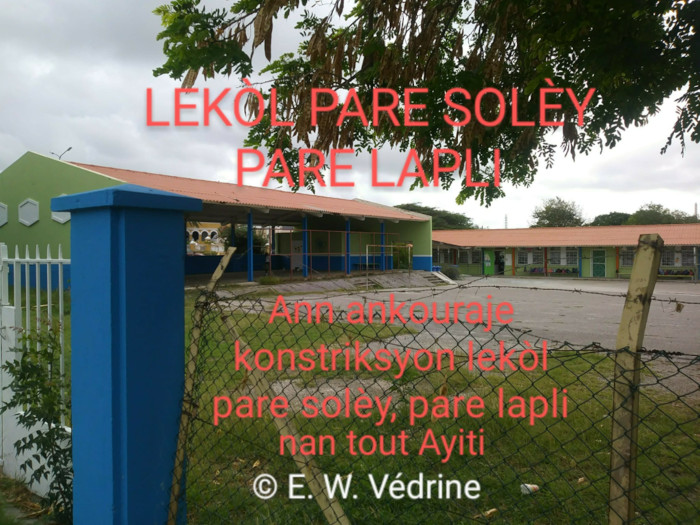
And how about the catching up level, for example, how did that work? For example, the students who were (functioning) at 4th grade level who could not read. How was the catching up done in order to put them at least at an appropriate level to function?
There is a term called to break the ice in English (to look for the truth). Sometimes you have to do Interviews to find out the truth, all problems these students had (in their country). From the interviews that you do, you can see exactly what level they left (school). Now, you are going to see what (teaching) materials you will develop to be adapted to their level in order to catch up quickly. I believe that we are parallel with you in this regard in terms of materials you were developing at the elementary level since you have focused on that level in this sense. Others, for example, may look at the middle school level. I stay closer to the High School level.
Now, let's focus on the issue because I mention the issue of putting students at their level. What kind of materials that had been developed at the time to make these students read and write in Kreyol?
What happened is that they had access to receive teaching materials in English. From September (when school starts) they lend them textbooks (math, social studies, history book…) and they would return them in June (end of the academic year). So, they would have access to these materials. You, as teacher who is teaching, know that they cannot speak English. So, you are going to read this textbook to understand and interpret it (for them). You would summarize it in Kreyol, and give them the terms in English. They will read them when they get home. Not only have you summarized it for them in Kreyol, now there are certain terms in English that you would retype to put them in alphabetical order. They would be on the right hand side with their meanings in Kreyol.
Well, vocabulary. That means you build up vocabulary to help the students.
Exactly! That is, you do all these works in the bilingual program to help them. So, it’s not all teachers who did it but me, I did it.
Very good! But now, concerning developing materials, that’s where I wanted to get with you.
Well, developing materials has taken a great extension. You have what’s called reading for example. So, you are looking at what materials are appropriate to develop for example based on your knowledge in the classroom - What materials have been developing? Am I developing this material, and then leave it in Kreyol only? Will I have it bilingual to help this student learning English at the same time the student also has the material in his / her native language for comprehension? That’s where you are going to see my materials are 100% bilingual.
Now, but were there other actors (people) who were developing materials also to be used at different levels, different regions in the United States where there is a Haitian population living?
Yes, there are many regions developing their own materials if we take HABETAC (Haitian American Bilingual Technical Center) for example in New York with Carole Berotte Joseph and her entire team. They already had a training with Yves Dejean, Albert Valdman for example. So what they did, they took these theories for instance after attending some seminars at Indiana University. They went back to HABETAC (New York). Those who were in Boston return there (such as Marc Prou, Nekita Lamour, Josiane Huducourt-Barnes, Lionel Prime, Isabel... and some Cape Verdean teachers in Boston). Me, I am another generation.
So, is this the team that Professor Albert Valdman prepared?
Yes. They were going to take these theories and apply them in bilingual programs when they went back to their regions (New York, Boston…), they're going to apply these theories.
O.K., but now we were getting another series of other teams also, for example Féquière Vilsaint (Florida), Deslande Rancher (New York) who were developing materials.
Féquière Vilsaint (Fekyè Vilsen) has lived in Canada where he studied Biochemistry. He moved to the United States. But his area is normally in science (biology, chemistry) together with (his wife) Maude Heurtelou for example who is a nurse. So, it's something normal to develop materials in your own area of expertise.
Exactly!
It's the same way you do it also.
Yes! Orèsjozèf Publications.
Exactly! For example, if you are teaching Mathematics*, it’s something normal to develop materials in Mathematics, or get training to develop materials in Mathematics. So, in every area you are, it is important now to develop material in that area, but we must be trained for that. That is, we are taking all the theories, and put them into practice now when we are developing them in a sense.
Now when looking at these types of materials, for example Haitiana Publications, Deslande Rincher, Féquière Vilsaint, and we have Orèsjozèf Publications. You came up with E. W. Védrine Creole Project (1992). What was the first material you developed as founder of E. W. Védrine Creole Project?
Well, given that I've been having my experience for six years (from 1986) when I started teaching, so I see dictionaries are very important. At that time the only dictionary that existed in the bilingual program as reference was the Trilingual dictionary, published by Indiana University-Creole Institute (1980), Albert Valdman (editor and project director). There were some Haitians who assisted him in editing it. He also had other teams working with him at the time. So, it’s that dictionary that we would find in the Haitian Bilingual Office. Perhaps New York also had it as referential dictionary. Understand? It came in 2 volumes (Haitian Creole - English – French Dictionary (Volumes I (582 p.) and II, Spiral binding). 1981 • Vol. II. French-Creole index, English-Creole index. ISBN 9780929236049, 0929236041. 298 p. [Trilingual dictionary. Publisher: Indiana University-Creole Institute • Project Director & Editor: Albert Valdma).
Yes.
So, it comes in two volumes.
Sorry that we don’t have them here with us.
Well, we’ll talk about that. They are still there. O.k.
Now, apart from Valdman who came up with it (this dictionary), I called it the produced dictionary. I called it like that because you know I used to sell books also.
Well, you had a good reputation, going back and forth to New York. I went once with you when Carole Berotte invited me to do a presentation at HABETAC on material development for Haitian Bilingual Program”. We remember that in March 1993. It was the same year that Professor Albert Valdman finished reading my dictionary (published in December 1992). He said, "Hey, now I'm going to invite him to start collaborating in my research." So he was going to send me a large section of (the manuscript of) the dictionary he was about to finalize with Rozevel Jean Baptiste (who did a Ph.D in linguistics in France). That was the first work I was going for Indiana University-Creole Institute. After that, he would give me other research works to work on such the transcription of some recordings that he did in Aux-Cayes (Okay), Haiti in the 60’s. I did these (working on the transcripts) while working at the same time on my biography research (Indiana University-Bloomington) one that would take me five years working on it.
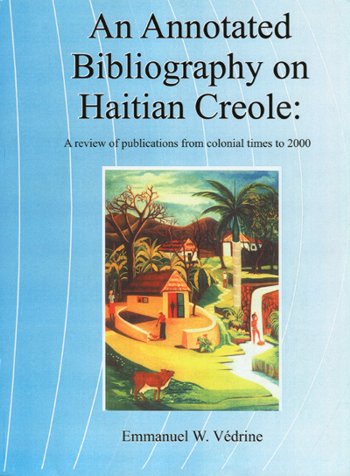
© Copyright 2003 by Emmanuel W. Védrine. 700 pages
We will get into this work. Now, you come up with Dictionary of Haitian Creole Verbs With Phrases and Idioms.
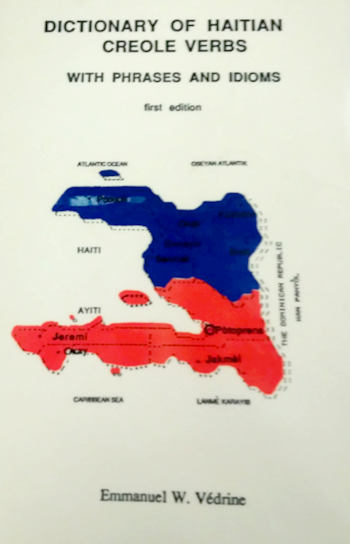
© Copyright 1992 by Emmanuel W. Védrine. 246 pages.
This is my first book on the Haitian Creole verbs system that was published in December 1992. This publication was going to mark me as researcher.
So with that, I see that (if I recall) in 1992 also, you came also with some other people who were writing in Kreyol.
We can mention Tony Jean-Jacques (1960-2000). In summer 1992, he was going to publish (his first book) Pour mieux t'aimer (8 x 11 format) and after that, his second book Moi, le Juif errant (1993, 96 p). During that summer, we were talking about that and he came up with a first book for the Haitian Bilingual Program. He was an incredible educator (who studied philosophy, French, Spanish, and was a certified teacher in these languages and also in Haitian Bilingual in the state of Massachusetts).
In that same year also, if you recall…
We went to CIDIHCA (Montreal) to publish it. The reason why he did not get it published with CIDIHCA was that he had some pictures in the book and the publisher needed their references (which the author could not provide right away).
O.k.
So, it would take him time getting the references. He finally got the book printed out by Imprimerie du Messie (in Montreal).
Yes, you also gave me that printing reference (Imprimerie du Messie).
Well, sometimes we forget about good things we do.
But you also brought another author, Jean Armoce Dugé, who came up with a collection of poems (Tribò Babò (1994). Boston, Orèsjozèf Publications, 1994).
Jean Armoce Dugé came on the scene in 1995 with his book that you published. Thank you that you remind me of the title. A collection of poems I reviewed for him. He had the chance to observe one of the Spanish classes I taught at Dorchester High School (1995).
OK. And then you’ve asked me to register it with an ISBN number.
Well, you already a bunch of ISBN in your possession that you bought. You ordered them in New Jersey if I am not mistaken.
From R.R Booker.
Well.
You also came with UNNOH. You can tell us about UNNHOH?
Well, we have published a booklet for UNNOH. We don't know if you recognize Frito Jean-Charles. They gave him my reference. Well, unfortunately he was at a restaurant in a Port-au-Prince. While he was making an order, he received 7 bullets (in the face). (The late) Dr. Paul Farmer helped him traveled to the U.S to get medical care. It was through that reference we met. He stayed in Mattapan Square (Boston), and we met each other there. We spoke as educators; I saw his work. Well, I was very interested. So, we helped him publish this little book.
Now, tell us about some other authors... for example I am one of them. I have a recent book that will be soon published entitled Easy English*. You did the major work in this book.
Thank you very much!
Well, that's you, that's true. What other authors that Emmanuel W. Védrine assisted in developing materials?
I revised Diksyonè Kreyòl Vilsen. Unfortunately, he did not mention that I revised and corrected in 1994 when I was student at Harvard University. I then mailed it to him. He did not mention that. Anyway, it’s a try out as the first monolingual dictionary. Much work is needed to be done in that book.
Apart from Vilsaint, are there other authors Emmanuel W. Védrine assisted in developing (teaching) materials?
There are several authors, and organizations (that revised or translated their works). They are many. It’s a long list, but they know me in a sense. You have for instance a project that Joel Theodat did for Pimsleur (Haitian Creole Audio Cassette). It's a nice project... They were supposed to produce 30 units (of the tape) for learners of Haitian Creole for example. Unfortunately, the (American) editor was a bit slow for all to be published on time... But it was a wonderful project where I reviewed its final version… Pimsleur is a great international publisher.
Yes, that’s true.
I brought my collaboration with MIT2 with Marilyn Mason & Jeff Allen.
Yes.
Who is Marilyn Mason? She is someone who was working on an extensive Haitian Creole data base. She typed the Bib la (from Genesis to Revelation) in Haitian Creole while working at M.I.T while she was secretary at the Chemistry department.
But you also introduced me to Marilyn Mason.
Well, I forgot all that.
I am reminding you of these things. So, you introduced me to Marilyn Mason with the books I was developing. Marilyn took a look at them to see if I had some corrections to be made. You are who made the reference.
Well, it's an entire data base reference they were trying to work on. Then we didn't know if Google would take all of this work now to place Haitian Creole as the only Creole language that can be translated automatically to Google Translate (from English to Haitian Creole).
A base.
Oh, yes! All that has been published online, Google makes (abstract) dictionaries with them. So, this is the advantage we have with Haitian Creole now. So far, Haitian Creole is the only creole language by Google Translate can translate automatically, which is among other languages in the world (which can be translated automatically).
Emmanuel W. Védrine, again it is an honor to have you in Tele Kreyòl, and I would not be at Tele Kreyòl to talk about Haitian Creole Month without including you. But you know it's a respect that it is within our community to have it here in Massachusetts. Now Védrine, there are other pioneers who contributed to the Kreyol language in other states as well. You have mentioned CIDIHCA.
I spent a month at CIDIHCA, looking at documents for my bibliography research. Frantz Voltaire welcomed me warmly. I checked everything that could be recorded on Kreyol. Every day I would take the metro (train) to CIDIHCA (in Montreal).
Well, let's talk about other states. In Florida, we know Féquière Vilsaint, Jan Mapou, etc ... And other states like New Jersey, we know there are many Haitians. We can mention Deslande Rincher in New York who is doing this job...
They do not work in collaboration with Emmanuel W. Védrine. We must be clear about that. Védrine collaborated with Indiana University-Creole Institute because Professor Albert Valdman has invited Emmanuel W. Védrine (after evaluating his work / publication of his Dictionary of Haitian Creole Verbs With Phrases and Idioms), but I still remain open, no matter who would send me a manuscript to look at. I am very fast (reviewing and editing), and I would ask them when they want the manuscript… For instance if they would like to have it in three months... If I say “yes”, they would have it before three months. So, I do this in a way to promote the Creole language. If someone wants to call it “collaboration”, no problem. But this is how I help promoting the Creole language.
So, it means that …
If someone sends me a manuscript (to look at), Védrine won't ask you for money to tell you, "Give me $300 for this 300 pages manuscript." No! Védrine won't ask for money to do this.
But at least give Védrine credits.
Well… There are people who want to give credit, and if they don’t no problem. The important thing is that we would like to see the book published. It needs to be published so that the Haitian public has access to it. Whether the person wants to mention my name or not, it is not a problem.
Well, that's why I call you “collaborator”. So, Védrine, I know you have been doing research at the Haitian Creole level, I think after taking a break I'll show that through potomitan you are one of the people who make Kreyol climb to that level.
I can say "one" of the contributors who pushes Haiti, because when we started as group in potomitan (mailing list), there were people from different places. I am from Haiti; I represent Haiti. There were people from Martinique • Guadeloupe • Seychelles • Rodrigues... So, I make sure that Haiti is represented and channeling maximum Haitians authors to help documenting their works on potomitan. Francesca knows that also, and she is very happy to help everyone (not just from Haiti). She also has been helping Haiti with her whole heart. She has found this channel through me where she found more space to help documenting Haitian author’s works, and this is very important for research.
So, in all these research that you have done that means you come to be in contact with different authors…
Well, many people have contacted me. If they don't have direct contact with the web editor (Francesca) who has been doing this work for 22 years. We don't have the money to pay her. There are people who have contacted me, and who are not in touch with her. I sometimes told them to give me their works and I would send it directly to Francesca (if she does not know them yet). Now, once the author begins to be familiar with her, that author can send his / her works directly to her. I try in a way to make sure that the works of Haitian authors and others who have contributed to Haitian Creole are documented. If a Haitian does not publish on potomitan, it is that person’s fault.
As long as it’s a book on Haiti, it will be documented because it’s a web site promoting creole cultures and languages around the world. It doesn't mean that everything should be done in Haitian Creole or if you don't write about Creole your book won’t be documented. No! As long you send a summary of the book (in Kreyol, French, English… about Haiti) about Haitian communities in diaspora, potomitan will document it for you because we have (an electronic) bibliography for that. We have an Online General Bibliography Related to Haiti is. Once the author sends the information to Francesca, she will add it automatically to that bibliography. Whether you talk bad about Védrine, it doesn't matter. One thing that is important, is that once you send the information it will be documented in Bibliographie Haïtienne et Indices Bibliographiques (Online Haiti’s Bibliography and Bibliographical Notes Bibliography Related to Haiti).
By what means do you send it to Francesca?
Electronically. Francesca Palli. She is on Facebook also for people who would like to be connected with her. Her native language is Italian, and her second language is French.
So the contact on potomitan is Francesca Palli, webmaster of potomitan.info.
A retired Biochemistry professor…
That means Francesca Palli is potomitan.
Potomitan was the name of a group (mailing list). They borrowed that name from one of the active list members, Kounta (from Martinique). Before that, the website was not called potomitan; it was called Kapes Kréyol* (Certificat d’Aptitude au Professorat de l’Enseignement du Second dégré)... So the GEREC (Groupe d'Études et de Recherches en Escape Créolophone) Group and (the late) professor Jean Bernabé for example has worked hard to bring a Capes Créole; we know that France has about 14 languages (and its territoire d’outre-mer or overseas territories).
(pause)
Thank you those who are watching Tele Kreyol. We bring you today’s broadcasting just so that we can remind you that October is Haitian Creole Month. And, every program that we do in the month of October, we will talk about Kreyol (my native language, the Native language of Emmanuel W. Védrine, and of Keish Désir) where you have been following here to witness Haitian culture. You who have children, you’ve been listening to a testimony of Haitian Culture. You who have children (born) in the United States, it does not mean that you can’t interact with your child(ren) inside the house in the Kreyol language, eating creole food, listening to creole music, and all that you know we do in creole. Emmanuel W. Védrine, we know that you participated in this Norwood festival, how was it for you?
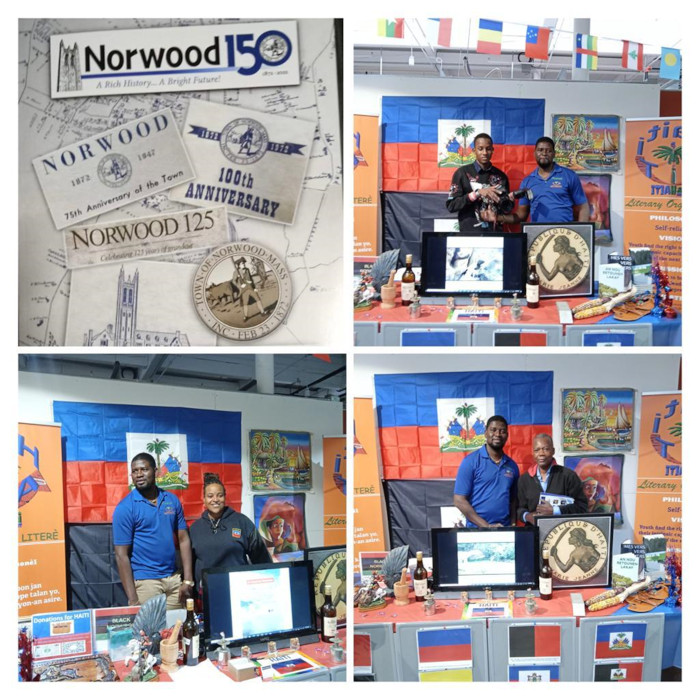
Photo E. W. Védrine Creole Project Archives
Well, it was great. There were many tables, representing different cultures. First, I thank Wilson Thelimo Louis (ITIA - Haiti) for the invitation he sent me by phone. It was great meeting Keish (leader of Black Norwood) who left Haiti at the age of one. It’s great to see her dynamism, and how she is interested in Haitian culture. So, it's a positive model for others who left Haiti at a young age or who grew up here (in the US) to know that they belong to a culture, and from there we met people from Portugal. I made 7 (seven) trips to Portugal while I was a student in Spain (Colegio De España, Salamanca), exchange program with the University of Massachusetts (Boston & Amherst) and the University of Rhode Island. On weekends when we were free, we would drive two hours from Salamanca to the Portuguese border, and sometimes we would drive all the way to Lisboa (the capital) four hours (from Salamanca, Spain). They were glad that I talked to them since I have driven through Portugal. I have been to places where Christopher Columbus had left for West Indies (thinking he was going to Asia). We met people at the Lebanese table. I have a friend of Lebanese origin in Curacao (Pais Kòrso) who is a writer. We were colleagues at French Table Club of Curaçao. Right there, I sent an email to that friend in Curaçao. Good contacts were quickly made with the (Lebanese) group of Norwood... I spoke to the people at the Syrian table. I told them there exists a Syrian community in Haiti; they did not know that. They were stun, and they warmly received me... I felt at home. To each table I went, I felt at ease. The Brazilians were practicing capoeira on a podium. One of the great capoeira instructors I met over 30 years ago, who was 70 years old, looked like someone in his 50s. I asked him what he had done to stay young... So here I am, watching Brazilians performing the capoeira dance, and it's a martial art the slaves used to practice in secret. They pretended they were just dancing, but it was a way to defend themselves in case of attack. Many people don’t understand what’s behind the capoeira dance for example. I was glad at each table I went to for this cultural event. It was really nice, and don't forget Oasis Cuisine was there. It makes good griyo*, good piklis* and good rice.
Rice and beans.
With red beans. Great stuff!
You’ve enjoyed this activity.
Certainly! There were different restaurants (Asian, Haitian…). It was beautiful! So, as it is a first edition, we hope the second one will be the more grandiose.
There will be more participation also.
Yes, there will also be more time for the Haitian community to be prepared to do a better representation, because these things are very important to make Haitians’ presence be known. Not only in Norwood, but also in (the state of) Massachusetts (what we bring as contribution for example, because they were showing several videos of May 18 (Boston, Canada, New York...), the Haitian Flag Day is so wonderful to sell our culture. How can we sell our culture? Is it dirty negative things we have to show all time? There are beautiful things we can share. Understand?
Emmanuel W. Védrine, but you are not in Massachusetts or in Boston, particularly full-time. But you tell me that you are Curaçao. You tell that you are in Curaçao. Tell us about the work that you are doing in Curaçao now in relation to publication, or writing, all that. Share it with the audience, you the viewers.
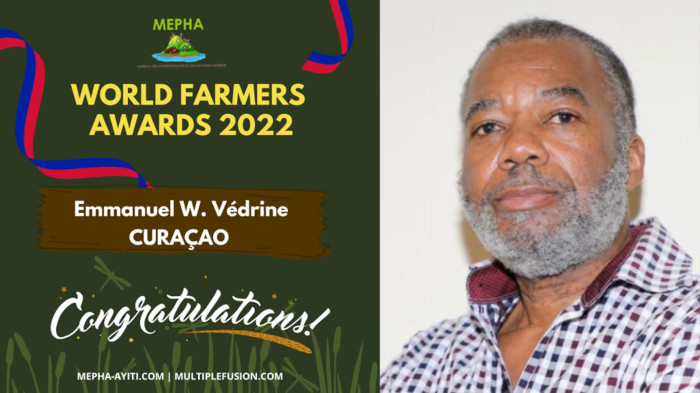
Well, It has been about 12 years since I am in Curaçao. My wife is a native of there. Her mother is of Haitian origin. Her father was a native of the land. So, I feel at home in Curaçao in a sense. There is a Haitian Community in Curaçao, and we must not forget the first immigrant from Haiti to Curaçao, President Faustin Soulouque.
O.k..
He took refuge there. He lived almost a year in downtown Curaçao (Punda - Otrobanda). After that, we are going to find other people. I had the chance to attend a meeting of (former) president Michel Martelly (Sweet Micky) in Otrobanda when he became Curaçao (February 2012). He is a friend of one of the former Prime Ministers (who was in office that year). The Haitian Community was waiting for him for 3 hours Otrobanda (to hear him speak). There were articles published newspapers about that visit. I also translated one into English (which was published in Papiamento). Immediately I arrived in Curacao, it didn't take me time to try to be in touch with Haitian community leaders. One important things is that when you recently arrive at a place is locating and knowing the community leaders. Once you get acquainted with the leaders, they themselves will introduce you to the community. I met community leaders like Benito Desroches, pastor Josias Joseph* (among church leaders)... Pastor J. Joseph, a native of Gonaives (Haiti) is the founder of the first Haitian evangelical church in Curacao. He is also businessman, a great builder and owner of a guesthouse (Jojo’s Guesthouse). So, Haitian communities in diaspora has a place to stay (as tourists), a Haitian guesthouse.
You have a reference where to stay in Curaçao.
Yes, a reference where to stay in Curacao. There are some Haitian restaurants... So, there are places where over Haitians’ houses who are doing businesses. One of the things that we are trying to do to there is promoting Haitian business through the community. I have animated an online forum for Benito Desroches (Ayisyen Ini nan Kiraso: United Haitians of Curacao), 2016–2017. I am also involved in the Christian Community of Curacao. We go to Church there, and sometimes we also visit Haitian churches so that we do not abandon our culture, and the Haitian community.
What’s the statistics of the Haitian population living in Curaçao?
Some people might say, “Well, 4 thousand Haitians." Some also have children born there. The fact that everyone speaks Papiamento, there are also Haitian children who attend University in Holland. Some don't explicitly claim to be of Haitian origin but little by little they have begun to emerge, telling their origin in a sense when they see positive things some Haitians in the United States and Canada are doing. They start out saying, "Yeah, my father is Haitian, my mother is Haitian." Little by little, the work is being done.
Now, we are done looking at the community issue, let's look at literary issue. Given that you are in Curacao, I believe you published two (2) dictionaries. Were you working on them while in Curaçao or, and then you edited them in Curacao?
Well the 2 (two) dictionaries projected on the screen are the work of Indiana University-Creole Institute. I am one of the (native) editors (for Haitian Creole) who contributed to them, especially in the 2007 version (Haitian Creole - English) published in (spring) 2007. Professor Albert Valdman (the project director) has asked me to be part of the project. Also, after that there is the reverse version (English – Haitian Creole) which was published 10 years later (winter) 2017. So, what's good in the English – Haitian Creole is that it costs less than $5 to buy its electronic version (with a credit card). Unfortunately, the Haitian Creole - English does not come with an electronic version so that the public could buy it. They have to buy it as book (hard copy). I was very happy to work on these projects that took 20 years. They are the two largest projects in terms of reference on the language. So, now if you want to work on a monolingual dictionary, if you want to work on a (bilingual) Haitian Creole – French dictionary you must look at these two referential dictionaries. I hope that all schools and institutions in Haiti have them as reference on the language.
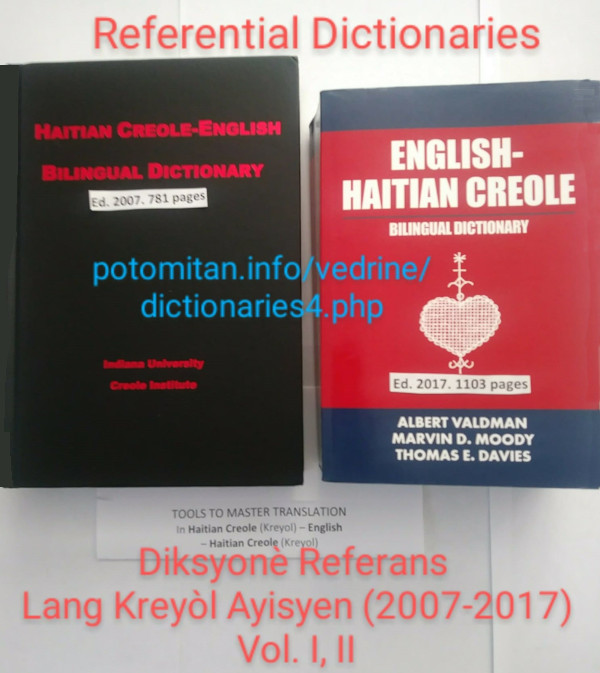
Photo: E. W. Védrine Creole Project Archives. The «Dico Project» Indiana University (1999-2017)
But are there steps being taken for schools in Haiti have them? I know there are bookstores or places where books are being sold in Haiti, like La Pléade, and others like Henri Deschamps …. Is there work being done to recognize these dictionaries, and their use?
Well, today via the internet the message is being circulated (on facebook, social media) everywhere. But now, it's people in Haiti - what they want, in a sense. For the electronic version (English – Haitian Creole), it doesn't even cost $5; that’s something important. So, people who are working on Haitian Creole should rush and buy it in order to have the database in their computer memory (or save it on a flash drive). But we know how things are being done on facebook, information… we need more people to circulate it. In a sense, materials that are being published on Haitian Creole. We need more circulation to let people know. As for me, I have tried to do my work for 30 years. So, I hope others do their part too when a new book comes out to help, by sending the information on facebook, and it's also good for the author to send the message to potomitan, because the web site does not charge for that (to send your book summary and the book covers [front and back] to them). It’s a great thing for the author to do that for documentation once for all.
Emmanuel W. Védrine, I know the works that you’ve been doing, the steps you're undertaking and research that you're doing. Now, personally where are you in terms of books you're writing? When is your next book coming out? What are you working on right now?
It’s a nice question. I can say that after a 30 years phase, every 10 year as leader show review his / her works. It’s good to go back and review what you have done. Now, it doesn't mean that there are new things I'm going to do. It’s a translation phase that is very important for authors to do, because many authors who are producing in Haitian Creole don’t have their works translated into English. So, it's a great deficit because there isn’t really a (large) market for books written in Creole languages. What is good to write in your local Creole language is that you can use all the materials produced (in the vernacular language, the native language) for basic education (for example in places where there may be a dominant language being used in education). That is true. The other phase would be to work on the second edition of some of my books (while alive).
Yes.
That’s what’s l call raw material* the Kreyol language, how we use the materials in the Kreyol native language, how they can be used and assimilated in education. And now, if you need a large market, they can be translated into other languages. So, in this second phase I try to focus more on the publication of my works in English.
O.k.
So, I have to focus on those that have not been published in English yet for a larger market, and to make a bit of more money.
Yes. From 1992 to the present day, 30 years, E. W. Védrine Creole Project has been existed. If you were to give yourself a prize as publisher, writer, researcher… what would it be?
Hmmm...
I'll give you 3 prizes: 1. Diamond 2. Gold 3. Silver. Which of the 3 prizes would you choose?
In sports we have: 1. Gold 2. Silver 3. Bronze.
Well, I don't put you in the bronze category. I come up with 1. Diamond 2. Gold 3. Silver.
I don't want to give myself a prize so that I don't get negative criticism. It's something that I leave it open. What’s more important to me is that I’ve seen the extension of my works while alive. That’s very important.
O.k.
And how they have been using them. I remember almost thirty years ago watching a white American who plunged into the reading of my first dictionary (Dictionary of Haitian Creole Verbs with Phrases and Idioms) on a crowded train (no idea if I am the author)... He has no idea if he were sitting next to the author.
Yes.
He put on his glasses to read. I was there watching him as he had plunged into reading of the book as learner of Haitian Creole.
How about your novel, Sezon sechrès Ayiti* (Season of drought in Haiti)?
It’s free online.
I know that it's a very successful book. What feedback do you get from Sezon sechrès Ayiti?
Success, in terms of copies that have been sold?
Success in terms of how many people respond to the text, and the content of Sezon sechrès Ayiti.
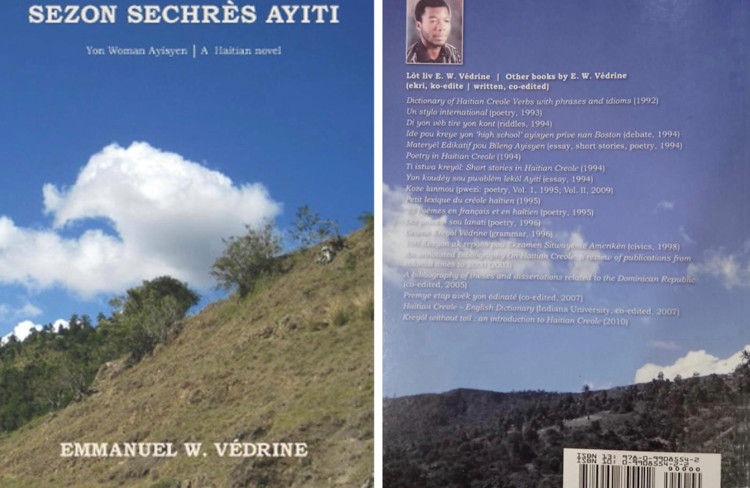
224 p. © by E. W. Védrine. 2014. JEBCA Eds.
Well, the advantage of Sezon sechrès Ayiti is that if you are at middle school level you will find yourself in it (no language barrier), it's very simple. If you are at high school level, no problem (with the ten chapters), you will find yourself in it. If you are at university level, now you will think more, and you will find yourself in it in a simple language and questions on the ten chapters. Everything is done (to help teachers who are using it). It is just the teacher who is teaching that has to use them, and give students questions to do homework. This book is free online.
Free!
Free! Electronic version. Just print it, use it in school, in literacy programs everywhere.
Can people access all of Emmanuel W. Védrine's books?
Some are free online. I've not yet published the second edition of my dictionary (published 30 years ago, Dictionary of Haitian Creole Verbs with Phrases and Idioms). It has been sold quickly.
Tell us about the books that people or viewers would be interested in E. W. Védrine Creole Project. Which of your books can they access electronically?
They will find some like • Essays’ models to help Haitian Students (high school and university level) with writing • Index of Gramè Kreyòl VÉDRINE Grammar of Haitian Creole • Ide pou kreye yon High School Ayisyen Prive nan Boston • Men l anlè a l ap vini (short story) • Petit lexique du créole haïtien (Historical linguistics) • Quelques plantes créoles et leurs noms en latin • Sezon sechrès Ayiti (novel : woman) • Yon koudèy sou pwoblèm lekòl Ayiti • 100 pwovèb Ayisyen… It would be important for all Haitians to read (my novel) Sezon sechrès Ayiti, and have their children read it also. The questions on the novel come into 3 languages (Kreyol, English, and Spanish). Why in Spanish? There is a large population of Haitians in the Dominican Republic, maybe you met (the late) Sonia Pierre (1963-2011 • Dominican Republic). I started giving her books (in 1994) when she participated in a conference at Harvard University (on International Women Leadership). So, she was a very active person. Unfortunately, she died in 2011. So I started giving her some books for her organization MUDHA to help with literacy... So I have many translations in Spanish.
Bibliography… Can people access E. W. Védrine's An annotated bibliography On Haitian Creole: A review of publications from colonial times to 2000 online? Particularly on potomitan?
For my bibliography, people can have full access to the titles, and the list of authors freely. One thing to mention is that it’s not the same as it has appeared in book format. If someone wants to buy this book, they can do so (ordering the first edition) from Educa Vision (for now). But all the references are free online.
Ok. Educa Vision of (state) Florida.
It was published in 2003. They (Educa Vision) put the book together. So that's where to order it (for now).
Well, what else would you like to share with our viewers to know, to those who complain, who are saying there is no material in Haitian Creole (Kreyol). What would you say in this case?
We cannot say there is enough materials in Kreyol, but we can say there are a lot of materials. There is a great online document that HABETAC published with respect to some materials produced in diaspora... I discovered it last year... So, there are many, many materials when going to my web link. Once typing the phrase "Emmanuel W. Védrine Potomitan", you will see my 30 years of works with all their references.
You, who are watching our program on Tele Kreyòl we have just mentioned that we are bringing some Haitians who are coming to talk about Kreyol. As I told you, Emmanuel W. Védrine had to visit us, and he came. Thirty years since he has been developing (teaching) materials. That’s a bibliographical reference. Next week, we will have with us Carole Berroute from HABETAC (Haitian American Bilingual Technical Center) in New York. So we are bringing Carole here for you though that will be via zoom you will see Carole Berotte Joseph. The way you see Védrine has spoken, Carole is one of the contributors of the Kreyol language in New York. Again, it was a pleasure with an honor to receive you in Tele Kreyòl, my friend, mentor, and editor Emmanuel W. Védrine.
Many thanks for the invitation. Hang on!
(End of interview)
*Note
•From the colonial times (before 1804). History of Haiti, Haitian Creole History.
* * *
ANNEXED TEXTS
- Variation in its writing. – Look at DEJEAN, Yves. 1977. “Comment Écrire Le Créole D'Haïti”. Indiana University. Degree: Ph.D. 554 p. + 1 page of the author's curriculum vitae. [Linguistics, Creole; Linguistics Haitian; Linguistics, Applied. Thesis also published in 1980 by Collectif Paroles (Canada). His linguistic publications appear in numerous journals and reviews both abroad and in Haiti. - Aménagement linguistique; Créole (description); Écriture; Phonétique-Phonologie. -- "Travail fondamental sur l'évolution de l'orthographe du créole haïtien: historique de la représentation graphique du créole à partir de la période coloniale, y compris les tentatives gallo-centriques non-systématiques; discussion des traits phonologiques du créole dans la perspective de l'élaboration d'une représentation graphique autonome à base phonologique; justification de l'emploi de l'orthographe Faublas-Pressoir comme système de représentation adéquat" (É. C. à Aix) [KRE].
- Easy English: an introduction to English for Creole and French speakers. © by Orèsjozèf (Oreste Renel Joseph). Edited by Emmanuel W. Védrine. • Glossary at the end of book : Glosè nan fen liv la (added by) Emmanuel W. Védrine (ajoute) -- including phrases and idioms in the two languages (enkli fraz ak espresyon idyomatik nan de lang yo • Introduction to English for Kreyol speakers (Entwodiksyon anglè pou kreyolofòn e frankofòn) • More than 1.400 words and idioms accompany them (Plis pase 1.400 mo ak espresyon ki vin ak yo) • An introduction to English Kreyol and French speakers [une introduction à l'anglais pour les locuteurs créolophones et francophones). Unpub. manuscript].
- Colonial times (17, 18 centuries) before 1804).
- High School (secondary school). Gade: Ide pou kreye yon High School Ayisyen Prive nan Boston (102 p.) [Idea to found a Haitian Private High School in Boston].
- Josias JOSEPH. (Curacao : Kiraso). IGLESIA UNION DI KRITIANAN (Église de l'Union Chrétienne). Pastors: Josias, Jocelyne JOSEPH. Address: Kaya Abnaci Rust en /Vrede A-7 Brievengat Bieu, CURAÇAO.
- MATHEMATICS – Reference of an advance Math textbook by Prof. Alfred Gérard Noël (University of Massachusetts-Boston). Text: Analiz Matematik: yon sèl varyab (Tòm I, 2èm ed.) • Analiz Matematik: plizyè varyab (Tòm II, 2èm ed.). JEBCA Editions.
- Raw Material (Matyè premyè). See : «Eklèsisman ak Demistifikasyon Tontongi nan liv li a, Critique de la francophonie haïtienne».
- Sezon sechrès Ayiti. (2nd. ed.). JEBCA Editions. 224 p. [English summary : Resumé en anglais]. [© The author’s copyright : © Dwa otè a]. [© Lexical data (for hyper base software for dictionaries): © Done leksikal (pou lojisyèl ipèbaz pou diksyonè)]. [In Papiamentu language, Temporada di sekura na Haiti. [First original Creole version was published in 1994: Soup to Nuts Publishers, Cambridge, MA. 1994. 128 p. [The novel has been translated to English by the author (Emmanuel W. Védrine). [Text in pdf format : Tèks an fòma pdf]. VEDCREP: Boston (edition, 2013, 163 p. [“In Sezon sechrès Ayiti, the author presents a Haiti the way it exists through the eyes of characters. Sezon sechrès Ayiti is a historical novel written in the Haitian language (Kreyòl) and one that is written in a simple language, presented in a historical, political and economic context: what happened in Haiti, what happened recently, and what continues to happen. The philosophy and psychology of the people are about the same: they all would like to see a beautiful Haiti, one where everyone can work together. They are victims of the drought, of the crimes going on in the country and abuses done to them. They are leaving Haiti for same causes though they like the country but the situation forces them to leave. Despite of all the crimes and abuses committed to them, they don't ask for anything wrong to happen to the criminals, but they would like them give up all that is evil, they would like them to change so that there can be a real change in the country”].
INTERVIEWS
2022. AKA (Akademi Kreyòl Ayisyen : The Haitian Creole Academy) -- E. W. Védrine’s intervention at the Akademi Kreyòl Ayisyen. Conference, February 4, 2. Keynote speaker, Emeritus Professor Albert Valdman (founder of the Creole Institute), Indiana University. Prof. Joseph Marcel Georges, Moderator. VIDEO • E. W. Védrine -- View of academy : Pwendvi sou akademi.
2022. Jojo’s Guesthouse in Curacao: an interview with the owner | Jojo’s Guesthouse nan Kiraso: yon entèvyou ak popriyetè a, pastè Josias Joseph.
2021. Oct. 12). Chatting on Bibliographies related to Haitian Creole [Kozri sou koleksyon sou kreyòl ayisyen]. Emmanuel W. Védrine, special guest. Fakilte Lengwistik Aplike, Inivèsite Leta Ayiti : Faculté de Linguistique Appliquée (FLA), Université d’État d’Haïti: Faculty of Applied Linguistics, State University of Haiti • LangSE (Laboratwa Lang, Sosyete e Edikasyon : Language Lab, Society and Education).
2021. «Tranblemanntè 14 dawou 2021 kraze komin Lazil (L’Asile) ak Sid Ayiti». Jounalis Frantzdy Jean-Baptiste, RTVA (Radio-Télévision L’Asile) ap entèvyoure majistra komin nan, Madam Ifeta.
2005.Entèvyou ak Diana Guillemin «lang kreyòl» (Interview with Diana Guillemin, Creole language).
2000. «Lè Kreyòl kenbe w (When have a need for Kreyòl». (Interview avec the Haitian linguist, Emmanuel W. Védrine celebrating his tenth year of research on Haitian Creole). Journalist Gotson Pierre, SICRAD, Oct.
1999.Interview: Emmanuel W. Védrine with André Vilaire Chéry”, related to his inventory of words / idioms documented during the political climate in Haiti, from February 1986 to 2000. --- It was a pleasure meeting each other during his visit at Indiana University- Creole Institute at the Bloomington Campus to share his research idea with us. (Dec. 10). [Dictionnaire De L'évolution Du Vocabulaire Français En Haïti (dans le discours politique, économique et social du 7 fev. 1986 à nos jours: Interview avec l’auteur, André Vilaire Chéry].
1996. First meeting with Eddy Le Phare. ('Lèt ak Kilti' : “Letters and Culture”, radio program). Feb.. (pdf, 43 KB).
1996. “Sitting down with Serge Claude Valmé to discuss about the first seminar of E.W Védrine Creole Project”. June 1996; ref. in Gramè Kreyòl Védrine.
* * *
ALLEN, Jeff. [Mother tongue: English; Expert in speech and translation technologies, certified Quality auditor, also specialized in Creoles. Specialization: telecom, automotive, heavy-machinery, engines, computer science, information technology, predictive analytics, business intelligence, data warehousing, theology, machine translation, dictionary building, MT post editing, controlled language, controlled English, technical communication, authoring guidelines, global branding, brand management, translation tools, translation memory, GMS Globalization Management System, TMS Translation Management System, terminology management, glossaries, creole].
ALLMAN, Suzanne. 1994. L’Inventaire des ressources lexicales en créole haïtien: présentation d’extraits du lexique de la maternité et de l’accouchement. Conjonction 161-162 : 133-150.
BERNABÉ, Jean. La production écrite créole et son support concret, la graphie. Version créole haïtien (Pwodiksyon kreyòl ekri e sipò konkrè l, grafi a) : Emmanuel W. Védrine.
CHERY, André Vilaire. Dictionnaire de l’évolution du vocabulaire français en Haïti (dans le discours politique, économique et social du 7 février 1986 à nos jours). (Vol I, II). 2000.
DEGRAFF, Michel. Clarification on fake research that being published on Haitian Creole (Kreyol), and lexicology. His latest article: «Verite se tankou lwil nan dlo»: #VokabiLasyon nan Inisyativ MIT-Ayiti, sa se leksikografi | Truth is like water – So here comes the truth about MIT-Haiti: Notes on vocabulary creation v. ‘scientific lexicography. [Michel Degraff if Professor of Linguistics at M.I.T, founder /Director of MIT-Haiti, Academician at the Akademi Kreyòl (Haitian Creole Academy)].
DEGRAFF, Michel (director). MIT - Haiti Initiative: • About (Sa l ye) • Events (Aktivite) • Funding • News (Nouvèl) • Organizations (Òganizasyon) • Questions about the Platform (Kesyon sou Platfòm lan) • Resources (Resous) • STEM (Science : Syans, Technology : Teknoloji, Engineering : Jeni, Mathematics: Matematik) • Team (Ekip).
---. Platfòm MIT-Ayiti Haiti – Electronic Teaching Materials in Haitian Creole (Kreyol) : Materyèl Didaktik /Pedagojik Elektwonik (dijital, nimerik) pou ede lekòl Ayiti, elèv e anseyan.
FATTIER, Dominique. Contribution à l’étude de la genèse d’un créole: L’atlas linguistique d’Haïti, cartes et commentaires. Doctoral dissertation (Thèse de doctorat d’État. Université de Provence (Aix-Marseilles I). Villeneuve L’Ascq : Presses Universitaires du Septentrion. ["L'objet de cette thèse est double: il s'agit de proposer un grand corpus d'haïtien parlé, tout en tenant, par le commentaire du corpus, d'éclairer la genèse de cette langue. L'enquête a porté sur 20 localités du milieu rural où ont été interrogés des témoins unilingues. L'enquête a permis de constituer une banque de données fiables. La plus grande partie de la thèse est dédiée aux commentaires (Vol. I et II) associés aux cartes (Vol. III, IV, V, VI). Cet ensemble est accompagné d'une introduction, de conclusions, de deux index et d'une bibliographie. Nous nous sommes intéressés par-dessus tout aux implications génétiques découlant de l'examen des données géolinguistiques. Ce qui explique qu'en règle générale, dans les commentaires, l'accent soit mis sur l'analyse diachronique et comparative. Nous avons cherché à mettre en évidence, de façon systématique, le rôle du français (koïnè d'oïl) dans la formation du créole haïtien. L'examen du matériau linguistique collecté a permis de progresser dans la compréhension du phénomène de la créolisation. Le résultat le plus saillant de l'étude est la mise en évidence du caractère massif de l'héritage français. Nous avons accordé moins d'attention au rôle des langues de l'Afrique de l'Ouest, sauf dans quelques commentaires et dans les conclusions où se trouve explicité ce qui a pu être des influences africaines au plan sémantique et syntaxique."
"The Linguistic Atlas of Haiti, Maps and Commentaries: Contribution to the Study of the Genesis of a Creole Language.
The purpose of the study is twofold: first, to elucidate the general processus of creolization of language in Haiti; second, to provide empirical input for further works. Our study centered on 20 localities. The methodology consisted of extensive interviews with illiterate unilingual peasants. The Atlas brings together authentic data. The major part of this thesis is taken up my map's commentaries (Vol. I and II) and maps (vol. III, IV, V, and VI). The whole is rounded off with an introduction, a few conclusions (pp. 974-992), two index (pp. 993-1016) and a bibliography (pp. 1017-1029). We were interested, above all, in the genetical implications that ensued from dialect investigation using the geolinguistic methods of dialect analysis. In general, in the commentaries, emphasis is laid upon diachronic and comparative study. Of special interest to us was the role or influence of French (koïnè d'oïl) in the formation of Haitian Creole (HC). The storehouse of information on dialects that has been compiled has attributed significantly to our understanding of the creolization phenomenon. The most important finding is the major role of the French Language in the genesis of HC. Relative little attention was paid to West African influences, except in part of some commentaries, and in conclusions that discussed the African legacy. Both of the syntax and the semantics of HC show West African reflexes."].
FORTUNAT, Betty. Directory of the Haitian Community in the state of Georgia, United States.
FREEMAN, Bryant. Haitian. [Revised by Emmanuel W. Védrine. Indiana University. Fall 1999].
HAZAËL-MASSIEUX, Marie-Christine. (Curriculum Vitae). Docteur d'Etat (Lettres et Sciences humaines) -- Thèse (sur travaux) : «Le créole de Guadeloupe : de l'oralité à l'écriture». PUBLICATIONS (Parmi les nombreux livres et articles qu’elle a publiés): Aménagement linguistique et développement dans l’espace francophone; Bibliographie des études créoles, langues, cultures, société • «Chansons des Antilles, comptines, formulettes» • «De la transcription à l’orthographe – conférence inaugurale» [Le créole réunionnais et la question orthographique] • Dictionnaire contemporain des Pères de l’Église • Ecrire en créole (L’Harmattan, 1993): oralité et écriture aux Antilles • «Représentations du créole dans les années 1940». – [1] (2004). [Entretien avec Daniel Maximin /Dominique Chancé] • Les créoles à base lexicale française (l’essentiel français), Paris, Ophrys, 200, IX+ 166 p. • Les créoles, l’indispensable survie (Éds Entente, 1999) • Textes anciens en créole français de la Caraïbe : histoire et analyse (Publibook, 2008) • Une pensée par jour; «Situation et communication linguistique». -- Introduction à la langue et à la culture créole des Petites Antilles. (Sommaire; Introduction • Quelques articles de présentation générale des créoles • Une bibliographie de base pour commencer l’étude des créoles • Des chapitres du cours traduits en anglais par Clare Ferguson -- TEXTES ANCIENS (ancient texts): A propos des textes anciens (About ancient texts) • Catéchisme de l’Abbé Goux (Catechism of Abbé Goux) • Choucoune d’Oswald Durand, 1896 --Choucoune by Oswald Durand, 1896) • Deux proclamation de Leclerc (Saint-Domingue, 1802 -- Two proclamations by Leclerc, Saint-Domingue, 1802) • Essai de grammaire de l’Abbé Goux, 1842 -- Abbé Goux’ grammatical essay, 1842) • Le loup et l’agneau, Marbot, 1846 -- The Wolf and the Lamb, Marbot, 1846) • Lisette quitté la plaine, version de Moreau de St-Méry, 1797 -- Lisette left la plaine, Moreau de St-Mery’s version, 1797) • Parabole de l’Enfant Prodigue Haïti, 1818 -- Parable of the Prodigal Son, Haiti, 1818 • Passion selon St Jean (Passion according St John) • Proclamation de Burnel (Guyane, 1799 : Burnel’s proclamation, Guyana, 1799) • Proclamation de Sontonax (Saint-Domingue, 1796) : Sontonax’ proclamation (Saint-Domingue, 1796) • Quelques éléments sur les français populaires dans la genèse des créoles (Some elements on popular French in creoles’ genesis). • Quelques proverbes antillais publié et traduits par Schoelcher, 1842 : Some West Indian proverbs published and translated by Schoelcher, 1842. -- ASPECTS CULTURELS (Cultural aspects): • Bibliographie des contes créoles (Bibliography of creole tales) • Comptines et formulettes (Nursery rhymes and formulas) • Contes créoles (Creole tales / folktales) • Formules introductives des contes (Introductory formulas of the tales) • Les personnages des contes • Les Tim-tim ou devinettes (The Tim-tim or riddle) • Littérature orale, Littérature écrite (Oral literature, written literature) • Proverbes (Proverbs) • Realia antillaises (Antillean realia). ASPECTS LINGUISTIQUES (Linguistic aspects): • A propos de la prononciation du créole (About the pronunciation of Crole) • Adjectives (Adjectives) • Créole et traduction (Creole translation) • Déterminants (Determiners) • Etimologie (Etimology) • Exercices supplémentaires (Additional exercices) • Faux-amis • L’écriture du créole (Creole writing /Writing in Creole) • La connection et les connecteurs (The connection and the connectors) • Le lexique du créole (Creole lexicon) • Le role des langues africaines dans le développement des créoles (The role of African languages in the development of creole languages) • Les créoles (creoles) • Les créolistes (creolists) • Les dictionnaires (Dictionaries) • Nom (Noun) • Petit glossaire (Small glossary) • Pronoms (Pronouns) • Quelques mots venus de langues africaineses (Few words from African languages) • Temps et aspect (Time and aspect) • Verbe créole (Creole verb) • Y-a-t-il un créole moderne? (Is there a modern creole?). ASPECTS SOCILINGUIStIQUES (Solinguistic apects): Alternance codique ou code switching • Continuum • La diglossie: Diglossia • La variation • Le créole français dans le monde (French-based creoles in the world) • Le statut des créoles: The creoles status. DONNÉES LITTÉRAIRES (Literary data): • Auteurs créolophones et francophones (de A–C): Creolophone and francophone authors (from A-C) • Auteurs créolophones et francophones (de D–M) : Creolophone and francophone authors (from D-M) • Auteurs créolophones et francophones (de N–Z) : Creolophone and francophone authors (from N-Z) • Bref panorama concernant la littérature de la Caraïbe (Brief panorama concerning Caribbean literature) • Quelques groupes qui ont marqués l’histoire des études créoles (Some groups that have marked the history of Creole Studies) • Quelques sites riches en informations pour travailler sur la littérature (Some sites rich in information to work on literature).
LORQUET, Joël. (Journalist). “Boukan dife literati ak Joël Lorquet”. INDEX : ENDEKS. NOTE: Atlantic Creole, Haitian Creole, Haitian Creole lexical data, Haitian culture, Haitian history, Haitian language, Haitian linguistics, Haitian literature, Interviews in Creole, Reading in Haitian Creole, Teaching materials in Haitian Creole | Créole Atlantique, Créole haïtien, Donnée lexicale, Culture haïtienne, Histoire d’Haïti, Langue haïtienne, Linguistique créole, Littérature haïtienne, Interviews en créole, Lecture en créole haïtien, Matériel didactique en créole haïtien.
OXINÉ, Bonel. Thèse de doctorat (doctoral /Ph.D dissertation). Pour une Sociodidactique du plurilinguisme du contexte martiniquais: enjeux institutionnels, didactiques et sociolinguistiques. Université Paul-Valéry Montpellier 3. Date de soutenance : 18 décembre 2019.
POTOMITAN and its WEBMASTER, Francesca Palli – The importance of this noble work to help documenting publications on creole languages and cultures in the world, over 20 years of hard works : Paj POTOMITAN e EDITRIS li, Francesca Palli – Enpòtans travay nòb sa a nan ede dokimante piblikasyon sou lang ak kilti kreyòl nan lemonn, plis pase 20 ane travay san souf.
SHAPIRO, Norma and Adelson-Goldstein. Oxford Picture Dictionary English-Haitian Creole. [Bilingual Dictionary for Haitian Creole speaking teenage and adult students of English. 2nd ed.]. 305 p. [Area of Study : Sijè pou etidye • Clothing : Rad • Community : Kominote • Every day language : Langaj chak jou • Food : Manje • Health : Sante • Housing : Kote moun rete (lojman) • People : Moun • Recreation : Rekreyasyon • Table of Contents : Tab Matyè yo • Transpòtasyon : Transpò • Work : Travay].
VALDMAN, Albert. (project director). English – Haitian Creole Bilingual Dictionary. Volume II (of the “DICO Project”). Indiana University. Native speakers editing team: Emmanuel W. Védrine, Frenand Léger, Jacques Pierre, and Nicolas André.
---. (project director). Haitian Creole-English Bilingual Dictionary. (Vol. I) Indiana University-Creole Institute. Volume I (of the “DICO Project”). Indiana University. Native speakers editing team: Emmanuel W. Védrine, Frenand Léger, Jacques Pierre, and Nicolas André. -- Selected Bibliography for the Indiana University- Creole Institute for the “DICO Project” (VOLUMES I & II), Albert VALDMAN, project Director and Editor • Vol. I: Haitian Creole – English Bilingual Dictionary. 2007. 781 + xxxiv pages (book format). ISBN 0-929236-06-8. Publisher: Indiana University-Creole Institute • Project Director: Albert Valdman • Editors: Albert Valdman & Iskra Iskrova • Assistant Editors: Jacques Pierre & Nicolas André • Editorial Assistants: Benjamin Hebblethwaite, David Levy, Emmanuel W. Védrine, Frenand Léger, Mary E. Fessner-Tarjanyi & Thomas E. Davies • Project Coordinator: • Research Assistants: Bruce Anderson, Rachel Anderson, Maria Kim, Don Reindl, David Rojas & Yseult Tomlinson • Clerical Assistants: Anupam Das, Jennifer Gerber, Helen Hathorn & Connie Phares. • NATIVE SPEAKERS EDITING TEAM: Emmanuel W. Védrine, Frenand Léger, Jacques Pierre and Nicolas André.
VEDRINE, Emmanuel W. An Annotated Bibliography on Haitian Creole: a review of publications from colonial times to 2000. 700 p.
---. Agriculture and irrigation in Haiti : Agrikilti e irigasyon an Ayiti.
---. A Bibliography of Theses and Dissertations related to Haiti (2011-2020), and a Bibliography of Bachelor’s Theses of FLA /Faculté de Linguistique Appliquée – State University of Haiti (compiled by Emmanuel W. Védrine, Joseph Marcel Georges and Fessando Suffren).
---. Ayiti va bèl lè n va antere negativite yo : Haiti Will be beautiful when we bury the negativities.
---. Bibliographie Haïtienne et Indices Bibliographiques: Online General Bibliography Related to Haiti (compiled by E. W. Védrine and Francesca Palli).
---. Bilingual Education in Haiti: Theory and Practice | Edikasyon Bileng Ayiti: Teyori e Pratik.
---. Chanje mantalite pou ranvèse kondisyon povrete Ayiti : Changing mentality to curb poverty condition in Haiti.
---. Chatting on Bibliographies related to Haitian Creole. [Kozri sou koleksyon dokimantasyon sou kreyòl ayisyen].
---. Collection of Haitian Education Materials by Albert Valdman.
---. Dictionary of Haitian Creole Verbs and Idioms by Emmanuel W. Védrine and research on Haitian lexicology.
---. Essays’ model to help Haitian Students (high school and university level) with writing. [Modèl esè (disètasyon) pou ede etidyan ayisyen (nivo segondè / high school e inivèsitè) ak ekri • Modelo de ensayos para ayudar a los estudiantes haitianos (nivel secundario y universitario) con la escritura • Essays-Modell, um haitianischen Schülen (Hochschul – und Universitätniveau) beim Schreiben zu helfen].
---. Educational Resources and Orientation Training for Haitian Teachers. Summary • Rezime • Sommaire • Resumen • Zusammenfassung.
---. Estrateji pou devlope wout Ayiti : Strategies to develop roads in Haiti.
---. Geography, Enivironment, Flora & Fauna : Jewografi, Anviwonnman, Flòr & Fòn. [Teaching materials in Haitian Creole, English & for Haitian Bilingual Programs].
---. Gramè Kreyòl Védrine. Boston: E. W. Védrine Creole Project. 354 pages.
---. Haitian Creole Database: Haïti Progrès. [Edited lexical data base model : Modèl bankdone leksikal tou edite : Modèle de banque de données lexicales éditées].
---. Haitian Creole Database: Kri pou liberasyon”. [(Cry for liberation), a collection of poems in Haitian Creole].
---. Haitian Creole Database : Writings By Emanuel W. Védrine (Part I).
---. INSMINOGEC (Institution Mixte de la Nouvelle Génération des Cayes) – Teaching Materials for Haitian Bilingual Programs in Haiti (courtesy E. W. Védrine Creole Project.
---. Interview with André Vilaire Chéry. [On the evolution of Haitian Creole, post dechoukay or after February 7, 1986]. Emmanuel W. Védrine. Indiana University–Creole Institute. December 1999. / Yon Entèvyou ak Vilaire Chéry nan kad rechèch li sou yon envantè mo ak espresyon li dokimantè nan konjonkti politik Ayiti a, soti 7 fevriye 1986 pou rive nan lan 2000]. Publication: Dictionnaire de l’évolution du français en Haïti (dans le discours politique, économique et social du 7 fev. 1986 à nos jours), Tome I, II.
---. Irrigation techniques to help Haiti : Teknik irigasyon pou ede Ayiti.
---. Jojo’s Guesthouse in Curacao : an interview with the owner (Josias Joseph).
---. Kèk tèm nan Sezon sechrès Ayiti pou disètasyon : Some themes in (the novel) Sezon sechrès Ayiti for essays.
---. Lang nan peyi Tonton Sam : Languages in the United States.
---. Modèl lekòl pare solèy, pare lapli ki ka konstwi tout kote Ayiti.
---. New Words and Idioms entering Haitian Creole : Mo Nouvo ak Espresyon ki antre nan kreyòl. [Text with translation in : Tèks ak tradiksyon an • Deutsch (alman) • English • Español • Français • Kreyòl].
---. Online Educational Resources for Haitian Teachers, Students, Schools in Haiti and in Diaspora
[Resous Edikasyonèl an Liy pou Anseyan Ayisyen, Elèv, Lekòl an Ayiti e nan Dyaspora]. Summary in : Rezime an: Deutsch • Español • Français • Kreyòl • Papiamento.
---. Open your eyes, Haitians! : Ouvè je w, Ayisyen!
---. Petit lexique du créole haïtien. Orèsjozèf Publications. 1995. 87 p. [historical linguistics / étude diachronique].
---. Retorik an kreyòl Ayisyen, tèks: Rat konnen, chat konnen, barik mantèg la sou siveyans.
---. Sezon Sechrès Ayiti: Questions on the 10 (ten) chapters | Kesyon sou 10 (dis) chapit yo | Preguntas sobre los 10 (diez) capítulos).
---. Techniques to formulate a research topic for dissertation and bibliographic orientation: Teknik pou fòmile yon sijè rechèch pou tèz, e oryantasyon bibliyografik.
---. Ten gifts for all Haitians : Dis kado pou tout Ayisyen.
---. Thirteen (13) important points to walk on the road of success: Trèz (13) pwen enpòtan pou mache nan wout siksè.
---. Twenty points in our resolution for 2023: Ven pwen nan rezolisyon nou pou 2023.
---. Welcome to L’Asile (Lazil), a commune in Haiti: Byenveni nan Lazil, yon komin Ayiti.
---. 75 Seventy-five Years of Research & Publications on Haitian Creole (Kreyol).
---. 30 Thirty Years of Research and Publications related to Haiti, Haitian Diaspora, and Haitian Creole : 30 Trant Ane Rechèch & Piblikasyon ki an rapò ak Ayiti, Dyaspora Ayisyen, e Kreyòl.
Research Note
• Bilingual education (in Haitian Creole / Kreyol - French, Creole – English) : Edikasyon bileng (an kreyòl ayisyen – fransè – anglè) • Creole linguistics: Lengwistik kreyòl • Creole literacy projects : Pwojè alfabetizasyon kreyòl • Creole philology: Filoloji kreyòl • Database in Haitian Creole : Bank done an kreyòl ayisyen • Dictionaries on Haitian Creole : Diksyonè sou kreyòl ayisyen • Dictionary and glossary projects : Pwojè diksyonè e leksik • Documents for training sessions for Haitian lexicographers : Dokiman pou fè seyans fòmasyon pou leksikograf ayisyen • Educational materials in English and Haitian Creole for schools in Haiti : Materyèl edikatif an anglè e an kreyòl ayisyen pou lekòl Ayiti • Educational materials for Haitian teachers’ training : Materyèl edikatif pou fòmasyon anseyan ayisyen • Educational resources, training and orientation sessions for Haitian teachers : Resous edikatif, trening e seyans oryantasyon pou anseyan ayisyen • French based Creoles : Kreyòl a baz fransè • Haitian Creole lexicon : Leksik kreyòl ayisyen • Haiti, Linguistic planning (amenagement linguistique) : Ayiti, amenajman lengwistik • History of the Haitian Bilingual Programs (in Massachusetts /Boston, the United States : Istwa Pwogram Bileng Ayisyen nan Massachusetts /Boston, Etazini • Materials for Long distance tutoring for learners of Haitian Creole : Materyèl pou bay leson patikilye long distans pou moun k ap aprann kreyòl ayisyen • Orientating Haitian teachers : Oryante anseyan ayisyen • Research on Haitian Creole Lexicology: Rechèch sou leksikoloji kreyòl ayisyen • Seminars for Haitian Teachers on Teaching Materials : Seminè sou materyèl didaktik / pedagojik pou anseyan ayisyen • Stragies to develop Teaching Material Models in Haitian Creole (Kreyòl) : Estrateji pou devlope modèl materyèl didaktik / pedagojik an kreyòl ayisyen • Teaching Materials for Haitian Bilingual Programs : Materyèl didaktik /pedagojik pou Pwogram Bileng Ayisyen • Teaching Materials in Haitian Creole (Kreyòl) for learners of the language (beginning, intermediate and advance level) : Materyèl didaktik /pedagojik an kreyòl ayisyen pou moun k ap aprann lang nan (nivo entwodiksyon, entèmedyè e avanse).
* * *
Courtesy
E. W. Védrine Creole Project, Inc. (1992)
Boston, Massachusetts. USA
*
